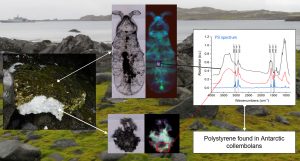Microplastics found in the Antarctic terrestrial food web
|Microplastics are plastic fragments below 1 millimeter in size, which can result from a variety of sources such as clothing, cosmetics, industrial processes and degradation of plastic items. They have been detected in air, water, and even in food. While their effects on human health are still under investigation, recent studies show that microplastics could affect the nervous, respiratory and digestive system, with the smallest particles capable of crossing cellular membranes. Regrettably, microplastics have been reported in almost every environment, even in remote areas like Mount Everest and the Mariana Trench. Recently, CERIC users presented the first evidence of microplastics in the Antarctic terrestrial food web.

Dr. Elisa Bergami and Prof. Ilaria Corsi, from the University of Siena (Italy), and colleagues, started their research from a large piece of polystyrene foam found in 2016 along the shores of King George Island (South Shetland Islands), about 120 Km from the Antarctic coast. The polystyrene piece was covered in algae, moss, and lichens, which feed different life forms. Among them, a 2 millimeter small invertebrate, Cryptopygus antarcticus, belonging to the Collembola group. Specimens of the Antarctic collembolan were taken and analysed at the Italian CERIC partner facility at Elettra Sincrotrone Trieste by Fourier Transform Infrared Microscopy (μ-FTIR), at SISSI beamline. The analysis of the samples, carried with the support of Dr. Giovanni Birarda and Dr. Lisa Vaccari, showed the presence of polystyrene micro-fragments below 100 μm in the digestive tract of the Antarctic collembolan. This result highlights a severe threat for the fragile Antarctic terrestrial ecosystem and implies that microplastics might have deeply entered the soil food webs also in less remote regions. Further research should investigate the ecological consequences of microplastics in soils in order to understand how extensive the threat is for the environment.
Below the interview with Dr. Elisa Bergami on the research work with extra contents from Antarctica:



